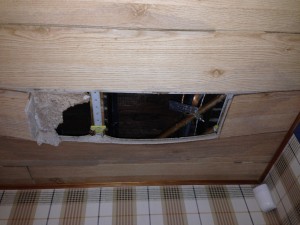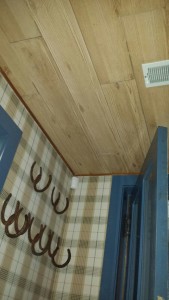As a painting and decorating contractor in the Chicago area, we are often asked to repair and match an existing decorative finish. We recently received such a request from a client. Her basement ceiling was clad with simulated wood planks made out of a material similar to that of acoustical tiles and wrapped in a vinyl that imitated rustic wood, including knots. The water had stained, bowed or destroyed seven of those boards. The entire ceiling covered about 500 square feet. The goal of this restoration project: Making it look like it never happened!
Achieving that goal is a lofty one. When you are the person who did the original work and have kept good records, the task is greatly facilitated. However, when it involves the work of others and no records exist, the task can be very challenging. This restoration project was of the latter sort.
Our carpenter’s investigation revealed that these planks were made in a tongue and groove style and that seven of the boards had been compromised. He concluded that the planks should replicated in wood, with the same dimensions, in the same tongue and groove style.
We then turned to our graining specialist to first replicate the colors of the wood grain. It takes a trained eye, patience and a willingness to experiment to arrive at the combination of colors. The next step was to mimic the style of the wood grain, including the knots present in the original planks. That process also involves experimentation with different tools and techniques. Finally, matching the sheen of the clear coat was the final touch to the restoration work. In this case, we used a dead flat varnish to match the surrounding sheen on the old planks. The second picture shows the final result: Mission accomplished!
In a way, the plank design made it easier to blend in the graining patterns, because there were no edges to contend with. When a decorative finish has been damaged, we must sometime redo the whole surface affected by the damage, because it is impossible to blend the edges of the repair. Because of the experimentation needed, the cost of a decorative finish repair can be disproportionately high. However, that cost is only a fraction of what a complete redo would be. In our house painting company, we do whatever it takes to meet a client’s need!









 Follow
Follow
